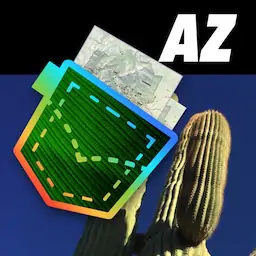by Alex Gugel , all rights reserved
BrochureMontezuma Castle / Tuzigoot |
Official Brochure of Montezuma Castle National Monument (NM) and Tuzigoot National Monument (NM) in Arizona. Published by the National Park Service (NPS).
featured in
| National Parks Pocket Maps |  | |
| Arizona Pocket Maps |  |
Montezuma Castle
Tuzigoot
National Monuments
Arizona
National Park Service
U.S. Department of the Interior
Photographs by William A. Bake
Ancient Farmers of the Verde Valley
These parks preserve remnants of two
distinctive cultures that once flourished in
the Verde Valley. The first permanent settlers
here were the Hohokam (Pima for "those
who have gone"). They were a skillful farming
people who moved into the valley shortly
after A.D. 600. They grew crops of corn,
beans, squash, and cotton and watered them
by irrigation. They lived in one-room houses
made of poles, sticks, and mud, which they
built on terraces overlooking their fields in
the bottomlands.
Another people also lived in this general
area. They were the Sinagua (Spanish for
About 1150 the Sinagua began building
their large pueblos, often on hilltops or in
cliffs. This was a time of concentration in the
valley center, probably in response to drought
and ensuing strife. The villages at Montezuma
and Tuzigoot reached their present size in
the 1300s and were occupied for another
century. In the early 1400s, the Sinagua
abandoned the entire valley. No one can
say why: perhaps too much pressure on the
land, perhaps conflict with the Yavapai, who
were living here when the Spanish entered
the valley in 1583. Whatever the reason or
reasons, the survivors were probably
absorbed into pueblos to the north.
"without water"), who inhabited the nearby
foothills and the plateau beyond the valley.
The Sinagua were pithouse dwellers and
dry farmers, dependent on rain for their
crops. They moved down into the valley
about 1125, occupying land vacated by some
of the Hohokam who migrated north to lands
made fertile by the ashfall from the eruptions
of Sunset Crater in the mid-1060s. The move
altered Sinagua culture in two important
ways: they adopted the irrigation system of
the Hohokam, and they began to build aboveground masonry dwellings, an idea they
may have borrowed from the Anasazi to the
north.
Daily Life of the Sinagua
The Sinagua of the Verde Valley were
peaceful village dwellers. They lived principally by farming but supplemented their
staple crops by hunting and gathering. Far
from austere, their surroundings supplied
them with more than the essentials of life.
There was abundant water in the central
valley, fertile land in the bottoms, and
sufficient game—including deer, antelope,
rabbit, bear, muskrat, turtle, and duck—to
augment a diet that leaned heavily on corn.
The Indians here were comparatively well
off in the important commodity of salt. There
was a deposit a few miles from the present
town of Camp Verde, and evidences of mining
there by the Sinagua are vivid.
The Sinagua were fine artisans. They made
stone tools of the usual variety: axes, knives,
hammers, and manos and metates for grinding
corn. They turned bone into awls and needles,
wove handsome garments of cotton, and
The potters at Tuzigoot
principally made underrated ware (left) of
not especially good
quality. Their vessels
were often coarse in
texture and porous and
weak. The best looking
pottery found here
probably originated in
the Hopi country and
was traded in. The
0)
m
<
fashioned ornaments out of shells, turquoise,
and a local red stone for personal decoration.
E
i
*£)
sz
o.
i en
'3
B
£
The Sinagua Room in
the Tuzigoot Visitor
Center gives us a
glimpse of everyday
life in Puebloan times.
Family tasks included
grinding corn, weaving
cloth from locally grown
Pottery was not a craft at which this people
excelled. They mostly turned out a reddishbrown plain ware in many sizes, which was
probably used for cooking and storage. The
decorated ware found here in great quantities
was traded in from neighbors to the north
and east.
The Sinagua were obviously daring builders,
if not as skillful with masonry as their Anasazi
contemporaries. The quality of the local
rock may have had something to do with
cotton, drying skins,
and making baskets.
this. It is fairly soft and of a type that splits
Two items suggest the
unevenly. Walls at Tuzigoot are massive but
trading network of the
Sinagua: macaws were
poorly balanced. Yet Montezuma Castle,
traded in from Mexico,
and some decorated pot- which admittedly is well protected, was so
tery came from the north. securely built that it has stood for over 600
years and is one of the best preserved
prehistoric structures in the Southwest.
pitcher and bowl be low
are good examples. The
bowl is of a type called
Jedditto Black-onYellow. Designs on
Jedditto bowls are
imaginative and almost
convey a sense of a
story. A characteristic
detail is a line around the
inner rim that is some times broken at one point.
Visiting the Parks
Photographs by William A. Bake
Montezuma Castle
Montezuma Well
Tuzigoot
Sinagua farmers began building this fivestory, 20-room dwelling early in the 12th
century. It stands in a cliff recess a hundred
feet above the valley. Early settlers marveled
at the structure and thought mistakenly that
it was Aztecan in origin. A short distance
west is Castle A, once an imposing six-story
apartment with about 45 rooms, now a badly
deteriorated ruin. This dwelling was built
against the base of the cliff. The Sinaguans
probably thought this was a good place to
live. The creek was a reliable source of
water, and there was fertile land on the
nearby terrace.
Montezuma Well has all the surprise of a
lake and fairly lush vegetation in the midst
of desert. The well is a limestone sink formed
long ago by the collapse of an immense
underground cavern. The springs that feed
it flow continuously. Both the Hohokam and
Sinagua irrigated crops with its waters. Traces
of their irrigation ditches, thickly coated
with lime, can be seen. The Hohokam
pithouse on view was built about 1100. The
Sinaguan dwellings here vary in size from
large pueblos of 55 rooms to one-room
houses. Between 1125 and 1400 about 150
to 200 Sinaguans lived here.
Tuzigoot (Apache for crooked water ) is the
remnant of a Sinaguan village built between
1125 and 1400. It crowns the summit of a
long ridge that rises 120 feet above the
Verde Valley. The original pueblo was two
stories high in places and had 77 groundfloor rooms. There were few exterior doors;
entry was by way of ladders through openings
in the roofs. The village began as a small
cluster of rooms that were inhabited by
about 50 persons for a hundred years. In the
1200s the population doubled and doubled
again as refugee farmers, fleeing drought in
outlying areas, settled here.
About Your Visit
Montezuma Castle is
near Camp Verde, on
1-17. To visit Montezuma Well, go north on
1-17 a few miles to
McGuireville. A side
road leads to the park.
Tuzigoot is near Clarkdale, off Alt. 89. The
centers with exhibits.
Yavapai-Apache Visitor
Center, located at the
junction of 1-17 and
Middle Verde Road,
offers information
about activities and historical places in the
Verde Valley. Both
Montezuma Castle and
Tuzigoot have visitor
Farther north are other
sites illustrative of the
Sinagua people: Walnut Canyon National
Monument on the outskirts of Flagstaff;
Wupatki National
Monument, 45 miles
north of Flagstaff on
U.S. 89; and Sunset
Crater National Monument, site of the last
series of volcanic eruptions in the Southwest,
events that significantly
influenced the course
of Sinaguan culture.
For Your Safety
Please stay on established trails—be alert
for snakes—avoid overexposure to the sun
and heat.
Administration
Montezuma Castle and
Tuzigoot National Mon-
uments are administered
by the National Park
Service, U.S. Department of the Interior. A
superintendent, whose
address is P.O. Box 219,
Camp Verde, Arizona
86322, is in charge.
i-GPO 1984-421-578/301


